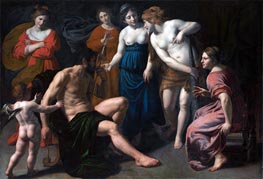
Alessandro Turchi Painting Reproductions 1 of 1
1578-1649
Italian Baroque Painter
Alessandro Turchi, known as L'Orbetto or Alessandro Veronese, was an Italian Baroque painter whose career moved between Verona and Rome, and whose work remains a fascinating balance of delicacy and drama. Born in 1578 in Verona, Turchi’s training began under Felice Riccio, known as il Brusasorci. It was in Riccio’s workshop that Turchi’s early skills were honed, but when his master died in 1605, Turchi’s path took a decisive turn. By then, he was already painting independently, completing works like the organ shutters for the Accademia Filarmonica of Verona, and stepping into a role of greater artistic responsibility alongside fellow painter Pasquale Ottino, completing Riccio's unfinished canvases.
Turchi’s style, often described as a softened version of Caravaggio’s intensity, is marked by a unique blend of light and shadow - a Caravaggesque chiaroscuro, yet tinged with a tenderness that was all his own. His work "Diana and Actaeon" captures this balance beautifully, where the mythological subject is rendered with both theatricality and grace. By 1616, Turchi had moved to Rome, a city alive with artistic competition. Here, he quickly established himself as a sought-after painter, contributing to major projects such as the frescoes in the Sala Reggia of the Quirinal Palace and creating cabinet pictures, often painted on black marble, which became highly prized for their refined elegance.
One of the most fascinating aspects of Turchi’s career is his ability to navigate the artistic demands of both Verona and Rome. He worked for some of the most powerful patrons of the time, including Cardinal Scipione Borghese, and produced numerous altarpieces, such as his "Resurrection of Christ" for the cathedral of Sant'Andrea in Bordeaux and his moving "Flight into Egypt" for the church of San Romualdo in Rome. Turchi’s Rome period saw him embroiled in the city’s vibrant art scene, where he was in competition with painters like Andrea Sacchi and Pietro da Cortona, yet he maintained his distinctive voice through his meticulous handling of light and form.
Turchi’s career flourished with prominent commissions, including work for the Farnese Palace at Caprarola, and he rose to positions of considerable influence. In 1637, he became the Principe of the prestigious Accademia di San Luca, and a year later, he joined the Pontifical Academy of Fine Arts and Letters of the Virtuosi al Pantheon. Despite his success, his art remained deeply tied to the emotional and spiritual power of his subjects. His works, such as "David with the Head of Goliath," resonate with a quiet intensity - capturing both the grandeur and the humanity of his themes. Alessandro Turchi died in Rome in 1649, leaving behind a legacy of paintings that reflect the elegant tension between the dramatic and the delicate, a hallmark of his Baroque sensibility.
Turchi’s style, often described as a softened version of Caravaggio’s intensity, is marked by a unique blend of light and shadow - a Caravaggesque chiaroscuro, yet tinged with a tenderness that was all his own. His work "Diana and Actaeon" captures this balance beautifully, where the mythological subject is rendered with both theatricality and grace. By 1616, Turchi had moved to Rome, a city alive with artistic competition. Here, he quickly established himself as a sought-after painter, contributing to major projects such as the frescoes in the Sala Reggia of the Quirinal Palace and creating cabinet pictures, often painted on black marble, which became highly prized for their refined elegance.
One of the most fascinating aspects of Turchi’s career is his ability to navigate the artistic demands of both Verona and Rome. He worked for some of the most powerful patrons of the time, including Cardinal Scipione Borghese, and produced numerous altarpieces, such as his "Resurrection of Christ" for the cathedral of Sant'Andrea in Bordeaux and his moving "Flight into Egypt" for the church of San Romualdo in Rome. Turchi’s Rome period saw him embroiled in the city’s vibrant art scene, where he was in competition with painters like Andrea Sacchi and Pietro da Cortona, yet he maintained his distinctive voice through his meticulous handling of light and form.
Turchi’s career flourished with prominent commissions, including work for the Farnese Palace at Caprarola, and he rose to positions of considerable influence. In 1637, he became the Principe of the prestigious Accademia di San Luca, and a year later, he joined the Pontifical Academy of Fine Arts and Letters of the Virtuosi al Pantheon. Despite his success, his art remained deeply tied to the emotional and spiritual power of his subjects. His works, such as "David with the Head of Goliath," resonate with a quiet intensity - capturing both the grandeur and the humanity of his themes. Alessandro Turchi died in Rome in 1649, leaving behind a legacy of paintings that reflect the elegant tension between the dramatic and the delicate, a hallmark of his Baroque sensibility.
1 Alessandro Turchi Paintings

Hercules and Omphale 1620
Oil Painting
$5696
$5696
Canvas Print
$56.29
$56.29
SKU: TUR-16798
Alessandro Turchi
Original Size: 166.5 x 237 cm
Alte Pinakothek, Munich, Germany
Alessandro Turchi
Original Size: 166.5 x 237 cm
Alte Pinakothek, Munich, Germany